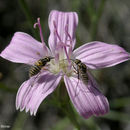en
names in breadcrumbs


Stephanomeria wrightii was described from western Texas. The type sheet has three specimens, all with a single, slender stem with paniculately disposed branches from a broken-off stub. A. Gray (1884, 1886) stated that those features indicated the plants were "seemingly biennial," and distinguished them from S. minor Nuttall (an old synonym of S. tenuifolia), which he said has "thick and tortuous roots." The slender stem of the specimens received by Gray may indicate their young age; they do not seem distinctive because other specimens from the same region have the bright white, fully plumose pappi and other features ascribed to S. wrightii, but also exhibit large, thick rhizomes. Gray noted that the "achenes are contracted under the summit"; this feature is not evident on the three specimens. Overall, S. wrightii does not seem different from S. tenuifolia.
The type specimen of Stephanomeria neomexicana, originally described as Ptiloria neomexicana by E. L. Greene, from New Mexico, exhibits multiple, long, flexuous stems with relatively few branches emerging from a stout rhizome. The pappi consist of plumose bristles, but the proximal 0.5–l mm is only minutely barbed. Plants with similar pappi are found occasionally in New Mexico and Arizona and differ in no other respect from S. tenuifolia.
Stephanomeria tenuifolia var. uintaensis grows "in one small isolated stand" (S. Goodrich and S. L. Welsh 1983) and was recognized primarily on the basis of relatively long phyllaries (10–16 mm) and runcinate-pinnatifid basal leaves. I measured phyllary lengths on isotypes; only one, from a terminal head, was 16 mm; others varied from 11–14(–15) mm. Although the lengths are 2–3 mm longer than typical, no other feature of the plants is unusual. Pinnately lobed leaves may not be typical of the species; because leaves are not often present on S. tenuifolia when it is in flower, and most specimens do not include them, the significance of the character is uncertain. The isotype collections are from young individuals and only the paratype from RM has cypselae. The variety does not seem worthy of taxonomic recognition.
Stephanomeria tenuifolia, the narrow-leaved wire-lettuce or narrow leaved stephanomeria, is a perennial plant in the family Asteraceae that grows in the Great Basin of the western United States.[1]: 60 It has five ray flowers that give it the appearance of being petals of a single flower of a plant in another plant family.[1]: 60
It grows with much branching from 1⁄2 to 2 feet (0.15 to 0.61 m).[1]: 60
Leaves are threadlike.
The inflorescence is a head with 5 square-tipped, petal-like ray flowers and sepal-like phyllaries.[1]: 60
Fruits are seeds attached to parachute-like pappi.[1]: 60
Narrow leaved stephanomeria grows in the plains and dry slopes in sagebrush steppe, mixed conifer, and mountain shrub communities in the Great Basin.[1]: 60 In California it can be found in sagebrush scrub, Northern juniper woodland, yellow pine forest, red fir forest, lodgepole forest, and subalpine forest plant communities.[2]
Stephanomeria tenuifolia, the narrow-leaved wire-lettuce or narrow leaved stephanomeria, is a perennial plant in the family Asteraceae that grows in the Great Basin of the western United States.: 60 It has five ray flowers that give it the appearance of being petals of a single flower of a plant in another plant family.: 60